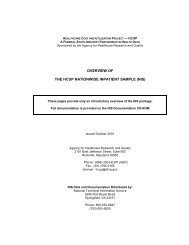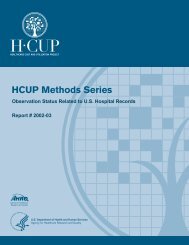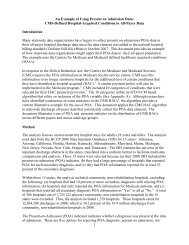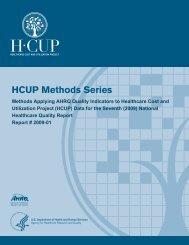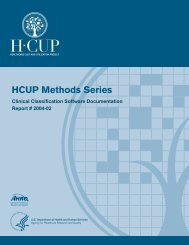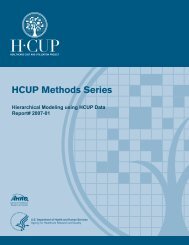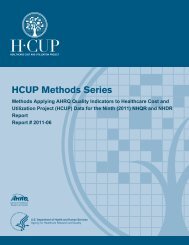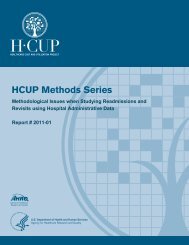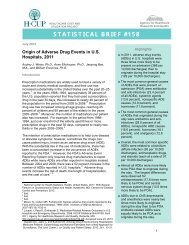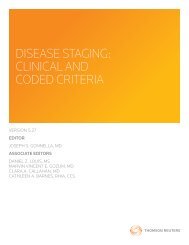Introduction to the HCUP Nationwide Inpatient Sample (NIS)
Introduction to the HCUP Nationwide Inpatient Sample (NIS)
Introduction to the HCUP Nationwide Inpatient Sample (NIS)
You also want an ePaper? Increase the reach of your titles
YUMPU automatically turns print PDFs into web optimized ePapers that Google loves.
5. Bed Size – small, medium, and large. Bed size categories were based on <strong>the</strong> number of<br />
hospital beds and were specific <strong>to</strong> <strong>the</strong> hospital's region, location, and teaching status, as<br />
shown in Table 7 in Appendix I. We chose <strong>the</strong> bed size cu<strong>to</strong>ff points so that<br />
approximately one-third of <strong>the</strong> hospitals in a given region, location, and teaching status<br />
combination would fall within each bed size category (small, medium, or large). We used<br />
different cu<strong>to</strong>ff points for rural, urban non-teaching, and urban teaching hospitals<br />
because hospitals in those categories tend <strong>to</strong> be small, medium, and large, respectively.<br />
For example, a medium-sized teaching hospital would be considered a ra<strong>the</strong>r large rural<br />
hospital. Fur<strong>the</strong>r, <strong>the</strong> size distribution is different among regions for each of <strong>the</strong><br />
urban/teaching categories. For example, teaching hospitals tend <strong>to</strong> be smaller in <strong>the</strong><br />
West than <strong>the</strong>y are in <strong>the</strong> South. Using differing cu<strong>to</strong>ff points in this manner avoids strata<br />
containing small numbers of hospitals.<br />
We did not split rural hospitals according <strong>to</strong> teaching status, because rural teaching<br />
hospitals were rare. For example, in 2009, rural teaching hospitals comprised less than<br />
2% of <strong>the</strong> <strong>to</strong>tal hospital universe. We defined <strong>the</strong> bed size categories within location and<br />
teaching status because <strong>the</strong>y would o<strong>the</strong>rwise have been redundant. Rural hospitals<br />
tend <strong>to</strong> be small; urban non-teaching hospitals tend <strong>to</strong> be medium-sized; and urban<br />
teaching hospitals tend <strong>to</strong> be large. Yet it was important <strong>to</strong> recognize gradations of size<br />
within <strong>the</strong>se types of hospitals. For example, in serving rural discharges, <strong>the</strong> role of<br />
"large" rural hospitals (particularly rural referral centers) often differs from <strong>the</strong> role of<br />
"small" rural hospitals.<br />
To fur<strong>the</strong>r ensure geographic representativeness, implicit stratification data elements<br />
included State and three-digit ZIP Code (<strong>the</strong> first three digits of <strong>the</strong> hospital’s five-digit<br />
ZIP Code). The hospitals were sorted according <strong>to</strong> <strong>the</strong>se data elements prior <strong>to</strong><br />
systematic random sampling. Detailed information on <strong>the</strong> design of <strong>the</strong> <strong>NIS</strong> prior <strong>to</strong> 2006<br />
is available in <strong>the</strong> year-specific special reports on Design of <strong>the</strong> <strong>Nationwide</strong> <strong>Inpatient</strong><br />
<strong>Sample</strong> found on <strong>the</strong> <strong>HCUP</strong>-US Website. Starting with <strong>the</strong> 2006 <strong>NIS</strong>, <strong>the</strong> design<br />
information was incorporated in<strong>to</strong> this report.<br />
Hospital Sampling Frame<br />
The universe of hospitals was established as all community hospitals located in <strong>the</strong> U.S. with<br />
<strong>the</strong> exception, beginning in 1998, of short-term rehabilitation hospitals. However, some hospitals<br />
do not supply data <strong>to</strong> <strong>HCUP</strong>. Therefore, we constructed <strong>the</strong> <strong>NIS</strong> sampling frame from <strong>the</strong> subset<br />
of universe hospitals that released <strong>the</strong>ir discharge data <strong>to</strong> AHRQ for research use. The number<br />
of State Partners contributing data <strong>to</strong> <strong>the</strong> <strong>NIS</strong> has expanded over <strong>the</strong> years, as shown in Table 2<br />
of Appendix I. As a result, <strong>the</strong> number of hospitals included in <strong>the</strong> <strong>NIS</strong> sampling frame has also<br />
increased over <strong>the</strong> years, as depicted in Figure 3, also in Appendix I.<br />
The list of <strong>the</strong> entire frame of hospitals was composed of all AHA community hospitals in each<br />
of <strong>the</strong> frame States that could be matched <strong>to</strong> <strong>the</strong> discharge data provided <strong>to</strong> <strong>HCUP</strong>. If an AHA<br />
community hospital could not be matched <strong>to</strong> <strong>the</strong> discharge data provided by <strong>the</strong> data source, it<br />
was eliminated from <strong>the</strong> sampling frame (but not from <strong>the</strong> target universe).<br />
Figure 4 in Appendix I illustrates <strong>the</strong> number of hospitals in <strong>the</strong> universe, frame, and sample and<br />
<strong>the</strong> percentage of universe hospitals in <strong>the</strong> frame for each State in <strong>the</strong> sampling frame for 2009.<br />
In most cases, <strong>the</strong> difference between <strong>the</strong> universe and <strong>the</strong> frame represents <strong>the</strong> difference in<br />
<strong>the</strong> number of community, non-rehabilitation hospitals in <strong>the</strong> 2009 AHA Annual Survey<br />
Database (Health Forum, LLC © 2010) and <strong>the</strong> hospitals for which data were supplied <strong>to</strong> <strong>HCUP</strong><br />
<strong>HCUP</strong> <strong>NIS</strong> (09/06/2011) 21 <strong>Introduction</strong>



